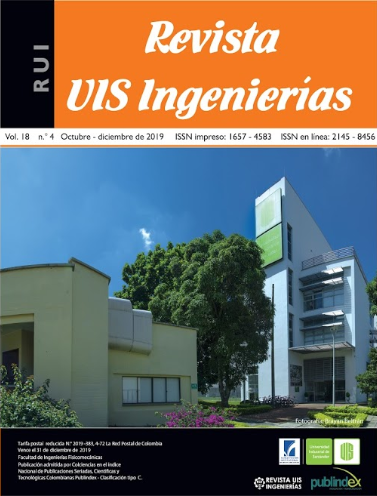Publicado 2019-08-09
Palabras clave
- algoritmos de clasificación,
- control de aeronaves,
- control tipo servo,
- máquinas de soporte vectorial,
- modelo en espacio de estados
Cómo citar
Derechos de autor 2019 Revista UIS Ingenierías

Esta obra está bajo una licencia internacional Creative Commons Atribución-SinDerivadas 4.0.
Resumen
En este artículo se presenta un sistema de detección que genera una alarma cuando existe un estado de anormalidad en el sistema de control de estabilidad de una aeronave. A partir del modelo latero dimensional y longitudinal se diseña un controlador tipo servo con integrador para la regulación del Roll, Pitch y Yaw. Los modelos son excitados con escalones de magnitudes aleatorias y perturbados con diferentes señales aleatorias para generar la base de datos de estados adecuados y no adecuados. Se utilizan clasificadores de base radial, los cuales se entrenan y se validan para la detección de los comportamientos anómalos que se puedan presentar en la estabilidad de la aeronave. La exactitud obtenida con los clasificadores fue superior al 93.33% para todas las variables estudiadas, lo cual indica que las técnicas de control y clasificación utilizadas, ofrecen fiabilidad en la determinación de los estados anómalos en la simulación del vuelo de la aeronave y que podrían ser utilizadas en vuelos reales.
Descargas
Referencias
[2] La Razón, «La Razón,» 12 Abril 2015. [En línea]. Available: http://www.razon.com.mx/spip.php?article255760.
[3] M. G. Skarpetis, F. N. Koumboulis, and A. S. Ntellis, “Longitudinal flight multi condition control using robust PID controllers,” in IEEE 16th Conference on Emerging Technologies & Factory Automation, ETFA, 2011, pp. 1–7. doi: 10.1109/ETFA.2011.6059071.
[4] Z. Ren, W. Wang, and Z. Shen, “New robust fault-tolerant controller for self-repairing flight control systems,” J. Syst. Eng. Electron., vol. 22, no. 1, pp. 77–82, 2011, doi: 10.3969/j.issn.1004-4132.2011.01.009.
[5] D. Viúdez-Moreiras, I. Martín, and J. M. Martín-Sánchez, “A new pitch angle adaptive control design,” in 2014 International Conference on Unmanned Aircraft Systems (ICUAS), 2014, pp. 928–935. doi: 10.1109/ICUAS.2014.6842342
[6] K. E. Terrell and S. Zein-Sabatto, “Integrated fuzzy controllers for aircrafts under faulty flight conditions,” in IEEE SOUTHEASTCON 2014, 2014, pp. 1–6. doi: 10.1109/SECON.2014.6950679
[7] N. Wahid and M. F. Rahmat, “Pitch control system using LQR and Fuzzy Logic Controller,” in 2010 IEEE Symposium on Industrial Electronics and Applications (ISIEA), 2010, pp. 389–394. doi: 10.1109/ISIEA.2010.5679436.
[8] A. H. Bajodah, H. Mibar, and U. Ansari, “Aircraft Motion Decoupling of Roll and Yaw Dynamics Using Generalized Dynamic Inversion Control,” in 2018 26th Mediterranean Conference on Control and Automation (MED), 2018, pp. 1–9. doi: 10.1109/MED.2018.8442505.
[9] G. Călugăru and E. Dănişor, “Improved aircraft attitude control using generalized predictive control method,” in 2016 17th International Carpathian Control Conference (ICCC), 2016, pp. 101–106. doi: 10.1109/CarpathianCC.2016.7501075.
[10] E. E. Galarza, C. A. Naranjo, O. Guijarro, D. Basantes, V. Enriquez, and D. Paredes, “Control algorithm for the inertial stabilization of UAVs,” in 2017 Annual IEEE International Systems Conference (SysCon), 2017, pp. 1–6. doi: 10.1109/SYSCON.2017.7934763.
[11] T. Hongpeng and Weibo, “Stability Control of Flight Attitude Angle for Four Rotor Aircraft,” in 2018 IEEE 9th International Conference on Software Engineering and Service Science (ICSESS), 2018, pp. 332–336. doi: 10.1109/ICSESS.2018.8663726.
[12] J. Shi, H. Yan, and X. Liu, “Multi-dimensional Taylor Network Optimal Control in Plane Symmetrical Cruise Missile Flight for Attacking Static Targets,” in 2018 IEEE 3rd Advanced Information Technology, Electronic and Automation Control Conference (IAEAC), 2018, pp. 457–462. doi: 10.1109/IAEAC.2018.8577696
[13] J.-P. Shi, J.-W. Liu, B. Lan, and P. Yang, “Adaptive variable structure control of flight control system,” in 2016 IEEE Chinese Guidance, Navigation and Control Conference (CGNCC), 2016, pp. 648–651. doi: 10.1109/CGNCC.2016.7828863.
[14] V. B. Larin and A. A. Tunik, “Synthesis of the quad-rotor flight control system,” in 2016 4th International Conference on Methods and Systems of Navigation and Motion Control (MSNMC), 2016, pp. 12–17. doi: 10.1109/MSNMC.2016.7783095.
[15] X. Yu, Y. Fu, P. Li, and Y. Zhang, “Fault-Tolerant Aircraft Control Based on Self-Constructing Fuzzy Neural Networks and Multivariable SMC Under Actuator Faults,” IEEE Trans. Fuzzy Syst., vol. 26, no. 4, pp. 2324–2335, 2018. doi: 10.1109/TFUZZ.2017.2773422.
[16] Y. Zhang, G. Tao, M. Chen, and X. Lv, “Adaptive control of uncertain nonlinear aircraft systems using combined linearized models,” in 2016 IEEE Chinese Guidance, Navigation and Control Conference (CGNCC), 2016, pp. 1156–1161. doi: 10.1109/CGNCC.2016.7828951.
[17] Y. Osa, S. Uchikado, and K. Tanaka, “Pitch angle control for hovering tilt rotor aircraft on one side rotor lift variation,” in 2017 International Automatic Control Conference (CACS), 2017, pp. 1–5. doi: 10.1109/CACS.2017.8284254.
[18] O. Vila Rovira, Modelización de aeronaves no tripuladas con Simulink. 2011.
[19] L. E. García Jaimes, Sistemas De Control Avanzado, 3ra ed. Politécnico Colombiano, 2013.
[20] K. Duan, S. S. Keerthi, and A. N. Poo, “Evaluation of simple performance measures for tuning SVM hyperparameters,” Neurocomputing, vol. 51, pp. 41–59, 2003.
[21] G. A. Betancourt, “Las Máquinas De Soporte Vectorial (SVMs),” Sci. Tech. Vol. 1, Núm. 27, vol. 1, no. 27, 2005. doi: 10.22517/23447214.6895.
[22] J. Á. Resendiz Trejo, “Las maquinas de vectores de soporte para identificación en línea,” Instituto Politécnico Nacional, 2006.
